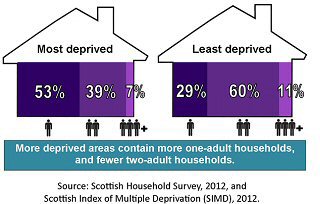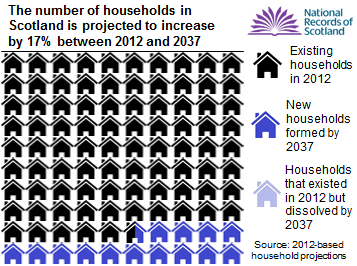Household Numbers Projected to Rise with Nearly a Quarter of Adults Living Alone by 2037
Household Numbers Projected to Rise with Nearly a Quarter of Adults Living Alone by 2037

Figures published today by the National Records of Scotland (NRS) show that the total number of households in Scotland is projected to increase by a sixth over the next 25 years to 2.78 million. Nearly a quarter of people aged 16 or over are projected to live alone by 2037, compared to about one in five in 2012. The number of people aged 65 and over living alone is projected to rise by a half, whilst the numbers more than double for those aged 85 or over.
Tim Ellis, the Chief Executive of National Records of Scotland, said:
“The number of households in Scotland is projected to grow by nearly 400,000 over the next 25 years. Most of this increase is in the older age groups. Scotland’s population is growing, but the number of households is increasing faster, due to changes in the types of households people are living in, and the ageing population.”
The figures also show that one-adult households are projected to increase by 300,000 over the next 25 years. There are smaller increases in households containing one adult with children (+41,000), and those containing just two adults (+139,000). In contrast, the number of larger households is projected to fall
(-84,000).
The biggest increases are among older households, due to Scotland’s ageing population. Older people are more likely than younger people to live alone. In 2037, it is projected that there will be 46,100 men aged 85+ living alone in Scotland, and 108,000 women.
However, the rate of household growth is slower than it used to be. For example, figures from Scotland’s census show that more young adults aged 20 to 34 are living with their parents instead of forming new households. This is probably due to it being more difficult for them to afford to set up homes of their own.

There tend to be more one-adult households (with or without children) in the most deprived areas, and more two-adult households in less deprived areas. More deprived areas also tend have a higher density of housing, more flats, and more dwellings in the lower value Council Tax bands.
Across Scotland, 2.8 per cent of dwellings are vacant and 1.4 per cent are second homes. These figures are much higher in remote rural areas (4.9 and 6.8 per cent respectively).
Council areas
Most Council areas are projected to have an increase in the number of households over the next 25 years, with the City of Edinburgh and Aberdeen City having the largest increases at 39 and 35 per cent respectively. The three Council areas where the number of households is projected to fall are North Ayrshire, Argyll and Bute and Inverclyde, with decreases of one, six and ten per cent respectively.
The full publications Household Projections for Scotland, 2012-based and Estimates of Households and Dwellings in Scotland, 2013 are available on the NRS website.
